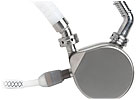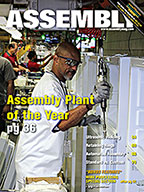New medical device assembly plant in Ann Arbor, MI, welcomes assemblers and engineers laid off from the automotive industry.


Terumo assembles the LVADs in a Class 100,000 clean room. Photo courtesy Terumo Heart Inc.
People with severe CHF have two treatment options: a heart transplant or a left ventricular assist device (LVAD). About the size of a hockey puck, an LVAD is implanted in the body to help the heart move blood from the ventricle into the aorta. In the next five to seven years, the worldwide market for LVADs is estimated at between $1.2 billion and $2.2 billion.
Perhaps it’s not surprising then that no fewer than nine medical device manufacturers are competing for a share of that market. One of them, Terumo Heart Inc., opened a new assembly plant in Ann Arbor, MI, in March.
A subsidiary of Japanese medical device manufacturer Terumo Corp., Terumo Heart moved to Ann Arbor from its original location in Tustin, CA. The new facility is located next to another Terumo subsidiary, Terumo Cardiovascular Systems.
Terumo Heart built the new 28,000-square-foot facility using a 2008 grant from the Michigan Economic Growth Authority. Terumo Cardiovascular also took advantage of the grant to build a new chemistry lab, remodel several buildings, and add office space.
“Our new, state-of-the-art manufacturing facility not only brings local prosperity, but allows us to produce a better product in a more efficient way,” says Bill Pinon, president and CEO of Terumo Heart. “We now have enough capacity to meet the needs of the next five years.”
The new facility will produce the company’s DuraHeart LVAD, which is currently being evaluated in a U.S. trial involving 140 patients. The study will evaluate the safety and efficacy of the device in helping to sustain patients awaiting heart transplant. In April, the company filed an application to study the device for long-term circulatory support. The DuraHeart carries a CE Mark and is currently available in Europe. Additionally, the company has completed clinical trial enrollment for the device in Japan.
Terumo assembles the LVADs in a Class 100,000 clean room. Electronic subassemblies and machined parts, such as the case halves, are supplied by contract manufacturers. Although most components have passed inspection before they arrive at the plant, some are still measured with a coordinate measurement machine to ensure they meet Terumo’s tight tolerance specifications. “The components need to fit precisely together,” says Dave Bucknam, vice president of operations at Terumo Heart.
Most assembly processes are either manual or semiautomatic. An automated laser welder joins the case components, providing a hermetic seal. All electronic components are tested to ensure that the circuitry is functioning correctly. “With a Class III implantable medical device, we need to ensure the device functions properly and sustains itself inside the patient,” says Bucknam.
By itself, Terumo Heart employs some 140 people, many of whom are castoffs from the automotive industry. “LVADs are complicated,” says Pinon. “There’s an electronic component, a mechanical component, a chemical component, a pharmaceutical component and a software component. Approximately 25 percent of our highly skilled workforce comes from the auto industry.”
Editor’s note: “Moving Forward” is a regular series profiling new or expanding assembly plants. If you know a facility that’s opening, growing or investing in new equipment, we’d like to hear about it. Send an e-mail to John Sprovieri, editor of ASSEMBLY, at sprovierij@bnpmedia.com, or call 630-694-4012.


